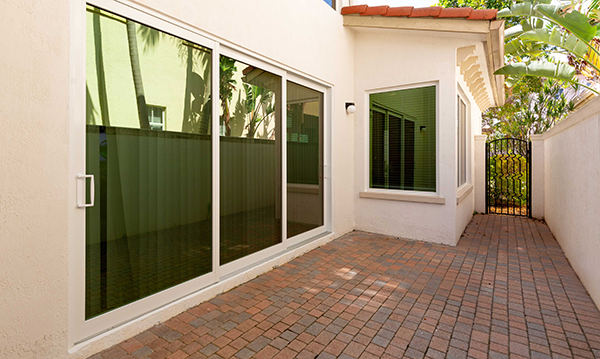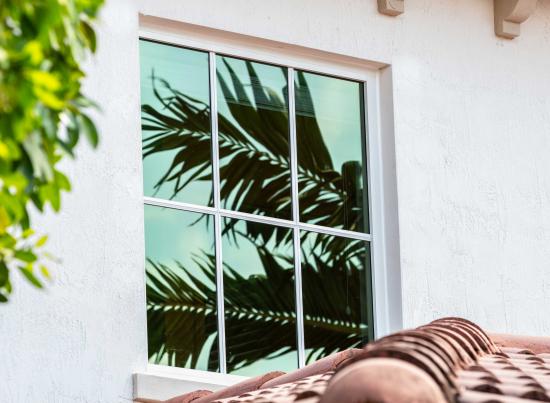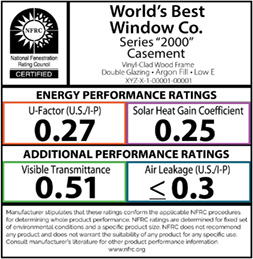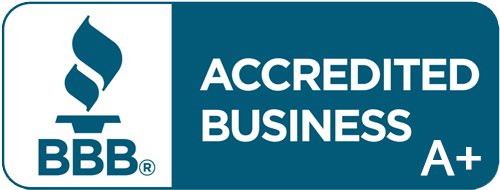Before the late aughts and early 2010s, most single-family homes and condos in South Florida were built with non-impact, single pane aluminum windows and doors. These are the least energy-efficient option for windows and doors. Because of the glass makeup and strict installation standards of hurricane impact windows and doors all impact products, even aluminum-framed products, are more energy-efficient than their non-impact counterparts.
Understanding Energy Ratings
To determine how energy efficient your impact windows and doors are, it is important to understand the different ratings given to windows and doors. All the following definitions are from the Office of Energy Efficiency & Renewable Energy, an office of the U.S. Department of Energy.
U-Factor
“U-factor is the rate at which a window, door, or skylight transmits non-solar heat flow… The lower the U-factor, the more energy-efficient the window, door, or skylight.”
Solar Heat Gain Coefficient
“Solar heat gain coefficient (SHGC) is the fraction of solar radiation admitted through a window, door, or skylight -- either transmitted directly and/or absorbed, and subsequently released as heat inside a home. The lower the SHGC, the less solar heat it transmits and the greater its shading ability.”
Visible (Visual) Transmittance
“Visible transmittance (VT) is a fraction of the visible spectrum of sunlight…that is transmitted through the glazing of a window, door, or skylight. A product with a higher VT transmits more visible light.”
VT is an important rating for any oceanfront property. Florida Coastal cities have Turtle Codes, the common name for ordinances dictating that any window or door that directly faces the water has a VT rating of 0.45 or lower to protect hatching sea turtles.
Air Leakage
“Air leakage is the rate of air movement around a window, door, or skylight…A product with a low air leakage rating is tighter than one with a high air leakage rating.”
Improving Energy Efficiency of Impact Windows and Doors
For projects that need to meet higher energy code standards, there are several impact window options that further improve energy efficiency. Some of our hurricane window and door options even carry an Energy Star Rating, meaning they meet stringent energy ratings for our region.
Frame Materials
Energy ratings take not only the glass into consideration but the frame as well. Therefore, the material used to construct the frame will directly affect the overall energy efficiency of a window. There are 3 window frame options to increase the energy efficiency of your impact windows and doors.
Thermally Broken Aluminum
Thermally Broken Aluminum is used to describe an aluminum frame made of 3 parts:
- Interior Aluminum Frame
- Plastic or rubberized middle layer of insulation
- Exterior Aluminum frame
The middle layer of plastic or rubberized material helps to prevent heat transfer between the 2 aluminum frames. “…by adding a break between the exterior and interior of a frame, window and door manufacturers prevent the transfer of heat or cold. The break creates an insulated barrier within the frame, which improves energy efficiency for the entire home.”
Wood-Clad
Wood-Clad is used to describe a frame constructed of 2 parts: a wood interior and an extruded aluminum “cladding” on the exterior. Wood is a natural insulator, therefore the wood interior framing helps to regulate the temperature inside the home, especially during drastic temperature changes outdoors. The more stable the home’s interior temperature, the less energy is used by the A/C or heating system to maintain the climate.
Vinyl
Vinyl impact frames are constructed with hollow chambers throughout the frame, serving as a good insulating material while maintaining the strength needed to reach high-impact ratings. “…vinyl windows have a secondary financial advantage in that they have very strong thermal performance ratings and are excellent at reducing air drafts. These qualities add up to lower utility bills and less wear and tear on your HVAC system.”
Glass
Tints
Tints are a coloration added to the glass itself, typically gray or bronze, and it helps to reduce both SHGC and VT. This means tints will reduce both the heat entering the home, and also reduce some of the natural light coming into the home, making rooms a bit darker.

Low-E
Low-E coatings, meaning Low Emissivity coatings, have a few different names depending on the manufacturer (Low-E, LoE, SolarBan, EnergyShield, Solar Control, etc.). These names all refer to a silver oxide coating applied to the glass that helps to reflect a large portion of the UV rays coming from outside. Those reflected UV rays help to reduce the SHGC, making your home cooler. The advantage over tints is that Low-E coatings will not affect the view, as no coloration is visible from inside the home. These coatings have the added benefit of preventing fading of furniture, artwork, and other finishes from those harmful UV rays.
Insulated glass
Insulated glass refers to a construction of glass that uses 2 pieces of glass separated by an airspace. In impact windows, one of these pieces of glass will be laminated glass (the technical name for impact glass) and the other is tempered. This pocket of air helps to absorb and trap heat from outside, decreasing the SHGC. It can also prevent the transfer of cold temperatures in winter conditions.
How Window and Door Installation Affects Energy Efficiency
How an impact window or door is installed is another factor in how energy efficient the product is going to be. When installed properly, the seal around the frame should be weather tight, which will prevent air leakage. The less air that leaks is good to help maintain temperatures, and therefore your A/C system should work less, saving energy and money.
Upgrading to hurricane impact windows and doors has a multitude of benefits along with improved energy efficiency and storm protection. To learn more about these benefits and the options available, request a free consultation with our remodel consultants or call 561-623-8446.




